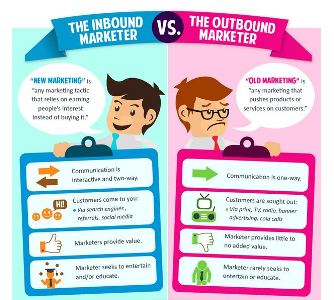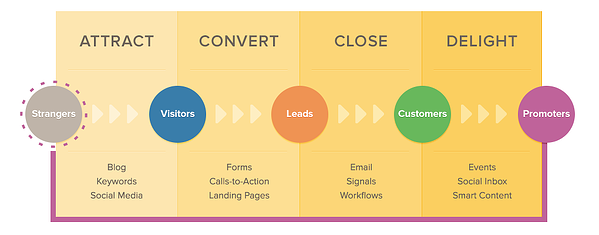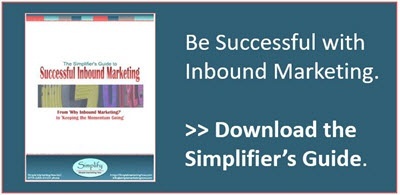
What's your definition of 'inbound marketing'?
For me, it has everything to do with building trust so you generate the right leads for your business.
Interestingly, since publishing this article in July 2012, quite a few marketing automation companies in addition to HubSpot have committed to inbound marketing and defined the term.
Here are the top four I came across.
Four Inbound Marketing Definitions
Let's start with the originator of inbound: HubSpot. According to HubSpot,
"Inbound marketing is focused on attracting customers through relevant and helpful content and adding value at every stage in your customer's buying journey. With inbound marketing, potential customers find you through channels like blogs, search engines, and social media.
Unlike outbound marketing, inbound marketing does not need to fight for potential customers attention. By creating content designed to address the problems and needs of your ideal customers, you attract qualified prospects and build trust and credibility for your business."
According to Marketo,
"Inbound marketing is a strategy that utilizes many forms of pull marketing – content marketing, blogs, events, SEO, social media and more – to create brand awareness and attract new business.
In contrast to outbound marketing, where marketers attempt to find customers, inbound marketing earns the attention of customers and makes the company easy to be found."
Optimizely's glossary says,
"Inbound marketing is a marketing methodology that is designed to draw visitors and potential customers in, rather than outwardly pushing a brand, product or service onto prospects in the hope of generating leads or customers.
In terms of digital marketing, this means using a combination of marketing channels – most commonly content marketing, SEO, and social media – in creative ways to attract people’s attention. The aim of a successful inbound marketing campaign is to increase reach, and drive quality traffic, engagement and conversions using ‘earned’ and ‘owned’ media."
And Pardot states,
"Inbound marketing means enticing buyers to come to you. It’s a way of meeting them where they are and engaging with them on their terms."
Inbound vs. Outbound Marketing
Here's another way of looking at it: inbound vs. outbound or new vs. old marketing where old focuses on pushing products and services on people and new prefers to earn people's attention.
This two-minute video from 2007 captures the essence of traditional outbound marketing. Titled The Break Up, it humorously dramatizes the relationship between an advertiser and a consumer.
How Inbound Marketing Outperforms PPC the Smart Way includes an infographic detailing the differences between new and old marketing. Although from 2012, it helps put effective marketing into perspective. Note that it has nothing to do with interruption, and everything to do with establishing trust and developing a relationship.
What is Inbound Marketing?
We've looked at different definitions; we know what it's not. Let's list what inbound marketing is when it comes to marketing.
1. Blogging
We're talking about blogging in a focused, persona-based approach while publishing consistently over time. This is not cookie-cutter blog articles that don't add value to the reader.
2. Lead nurturing
Lead nurturing done right develops slowly over time. It's thoughtful and relevant, with plenty of opportunity for the recipient to bow out if necessary.
3. Lead generation
Lead generation happens on your website or blog via targeted content offers. Offers need to be relevant to your visitors, and they evolve over time. An example of that is Pillar Content.
4. Permission-based emails
These are emails sent because you have obtained permission from the recipient. These are golden since your recipients have told you they want to hear from them. Don't mess it up. It's a matter of trust.

5. Samples in-store
Think Trader Joe's. I love their samples. They're usually served with context and a smile. Samples make me want to spend more time in-store and try out more things at home.
6. Social media engagement
We're talking real engagement on Twitter, Facebook, LinkedIn and other networks, including real-life networks. This means that you listen and respond accordingly.
By the way, this gets tougher as networks get noisier and more pay-for-play environments.
7. Content that speaks to visitors and search engines
Let your website content speak from the heart to your prospective customers. That means creating content that uses the language your prospects to while organizing the information in a way that search engines can recognize. Examples include your page titles, meta descriptions and image <alt> tags, as well as headers and subheads. Make it easy for readers to scan your content.
8. Earn your readers' interest
Inbound Marketing is "any marketing tactic that relies on earning people's interest instead of buying it."
9. Not interruption based
10. Has nothing to do with cold-calling
11. Forget broadcast TV ads
12. Not print-based ads
13. Can include PPC advertising
This one can be a surprise. Paid search or Adwords can provide insight on the language people use and the concepts they react to. It can also help jump start your inbound momentum.
>> See How To Get Started with Paid Search to Get Found Online: 15 Tips
14. All about referrals and earned media
Referrals and earned media imply trust. Reviews fall into this category.
15. Smart and honest search engine optimization
Inbound marketing embraces legitimate, smart and honest search engine optimization. It's not trying to cheat or pretend to be something it isn't. Really.
>> See SEO Tips: Having Fun with Title Tags and Meta Descriptions

16. Not about SHOUTING
Shouting (and using all caps) tends to imply that you aren't listening. Inbound marketing is more about 1:1 focused interactions that enable you to build and strengthen relationships.
It forces you to think how to transform any opportunity such as a trade show and transform it into a more meaningful interaction.
17. Doesn't force things on you.
Example: unwanted video experiences, or websites that immediately launched into noisy videos...
>> See Hall of Shame Inductee - LabCorp
18. If it does interrupt, it entertains deliciously
Examples of this include impromptu performances in public spaces that bring joy and amazement.
>> See Augmented Reality Ad Puts YouWith Angels in London Train Station - hat tip @RetailProphet
19. It's about targeted content offers that only those interested respond to
Yup. Relevant. Informative. Educational. Helpful. Honest. Trustworthy. Content.
20. It has nothing to do with buying mailing lists
When you buy lists, you are guaranteed poor email results. After all, these are emails that have no relationship with you and never opted into hearing from you.
21. And even less to do with buying links!
Stay away from buying links. It's dishonest and a bad idea. It will also get you into trouble with the search engine gods.

What Are You Trying to Do Through Inbound Marketing?
This gets back to where we started: the definition of inbound.
At the very heart of inbound marketing is drawing visitors in by virtue of remarkable content. In other words, being a magnet, rather than an interruptive nuisance that visitors run away from. One that visitors can get to know and trust over time.
You start with attracting visitors with your content.
Your remarkable and relevant website and blog content helps you get found online via search engines and social networks. It attracts readers to your site to learn more.

Then convert visitors into becoming leads.
This is where your relevant educational content becomes critical. Understand the problems your prospects have. Provide them with valuable insights.
Close your leads into customers.
By nurturing relationships over time, leads can become customers. Be sure to provide additional valuable content that further develops credibility and trustworthiness.
Delight your customers into becoming promoters.
Create a virtuous cycle whereby anyone you work with wants to help you succeed and vice versa.
Don't forget to analyze!

Focus on quality of leads rather than quantity
As important as generating leads for your business is, quality matters.
It's tough, though given how much focus there is on quantity. And yet if you focus on quality, you will see quantity as in website traffic improve. Not only that, that traffic is qualified and truly interested in your content.
Inbound marketing forces you to think intensely about your potential visitors. It gets you to focus on creating web content that is specific to distinct buyer personas, while being aware of the keyword search terms that resonate with them, and figuring out how to offer them valued information relevant to their stage of the buying cycle.
It makes sense.
When you create for visitors truly relevant content, they stay longer on your site, they come back for more and - most important - willingly offer up contact information in exchange for your valuable content offer. In other words, they become a lead. Once they do, you have the opportunity to nurture the relationship with them by offering additional useful bits of information sent directly to them via email.
Finally, every step of the way offers data you can analyze for additional insight and improve on what you do.
This type of thinking goes against creating splashy outbound giveaway campaigns that might draw 100s or 1000s of unqualified and mostly uninterested visitors. Inbound marketing is for the long haul, for businesses serious about long term and profitable relationships.

What's your definition of inbound marketing marketing?
What would you add to this discussion? What success have you had with any of these ideas? How do you go about building trust and generating leads?








